Plumbing in a private home
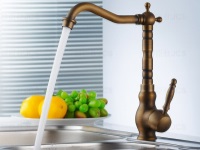
In any private house outside the city, one of the priority works is the plumbing. This case can not be called simple, especially if the construction of a long time is not new, but many works on the device plumbing can be done even with their own hands.
Scheme
Drawing a scheme can be called a fairly important matter, which is not desirable to neglect. When the decision to have plumbing is made, it is necessary to draw a scheme by which it will be laid in the house. It is important to consider all elements, including filters, pumps, boilers, manifolds, and so on. The path along which the pipes will be laid, as well as the placement of all other elements, are drawn on the scheme, along with the designation of distances. This will help to calculate the required number of pipes.
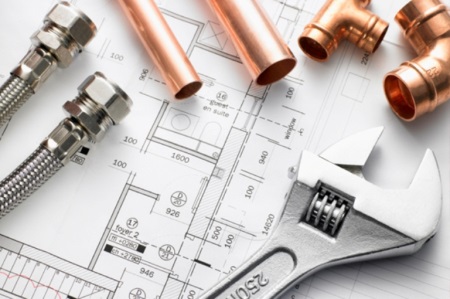
In the scheme of laying pipes can be marked in 2 ways:
- Connecting in series. Recommended for small houses, because this scheme requires a main pipeline, and from it to each water consumer is provided with a tee. With a large number of consumers the pressure will be insufficient.
- Using a manifold. Individual pipes depart from it to the consumers, so the pressure will be equal in all parts of the house. The cost of this option is more expensive, since the number of pipes will be more.
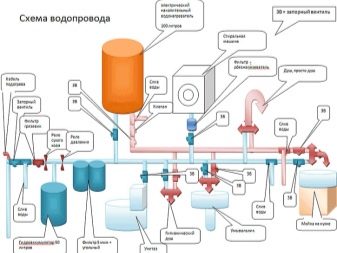
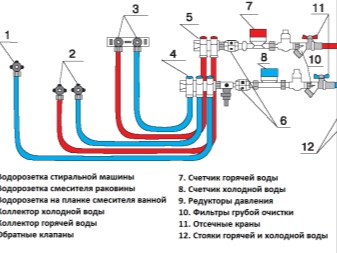
Consider the most common scheme. The pipe from the source of water intake is conducted in the direction of the pumping station, where there is a valve that prevents the return of water. The outlet pipe pumps water to the hydraulic accumulator, and a tee is installed behind it. From the accumulator there are pipes for technical needs and for domestic water supply.
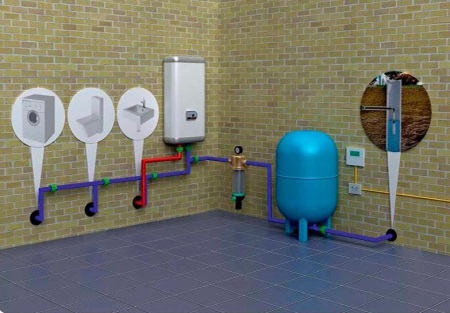
The pipe that conducts the water for use in the house is led to a treatment system to rid the water of harmful impurities. Behind the water treatment system again mount a tee provided for water separation. The pipe that conducts the cold water is directed to the collector, and the pipe that conducts the future hot water is brought to the heater. On the lines to the water consumers from the cold water collector put shut-off valves. From the water heater pipe passes into the hot water collector, and then the pipes are distributed throughout the building.
Installation with their own hands
The most difficult and dusty work during the laying of the water pipe is to create holes in the floor and walls. The remaining tasks (to cut and connect pipes, install a pumping station, connect filters, connect pipes to the collector and water consumers, and others), although they take a lot of time, but do not require considerable physical strength. Therefore, even a beginner can arrange everything himself.
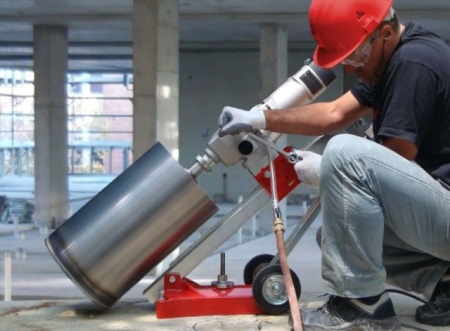
Types of pipes depending on the material
Having planned the installation of plumbing, the first task will be to choose the pipes, in particular the material from which they will be made.
Copper
These pipes are the most expensive, but they are considered the best. Pipes made of copper are not harmed by corrosion, microbes, ultraviolet radiation, increased pressure, temperature differences, harmful additives in the water.
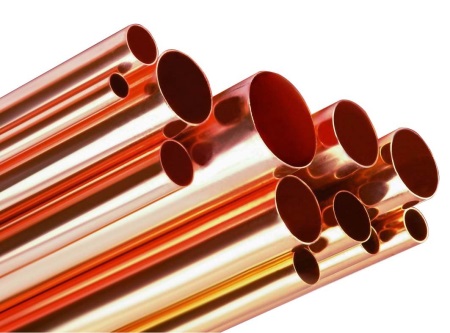
Metalloplastic .
These are aluminum pipes finished with plastic on both sides. Such pipes do not accumulate deposits, rust does not develop. They are not affected by condensation or ultraviolet light from the outside. Minuses of such pipes - sensitivity to increased temperature (deformed at 95 degrees and above) and freezing.
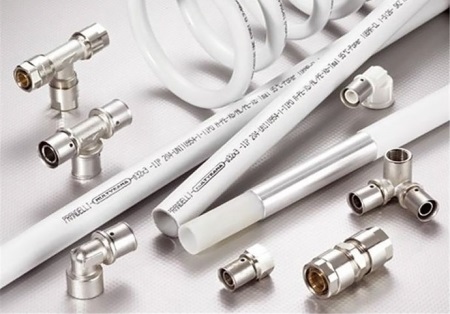
Steel
The advantages of steel: durability and strength. Disadvantages: the formation of rust, labor intensity of work (the need for welding and threading at joining).
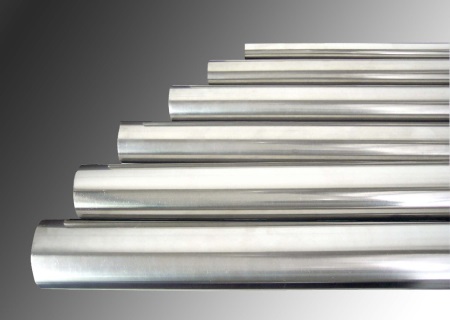
Polypropylene
They are distinguished by good technical characteristics, durability (last 50 years), ease of installation. For hot water supply there are polypropylene pipes with reinforcement.
Such pipes do not oxidize and do not need frequent testing, so they can be hidden under plaster. The only difficulty in selecting such pipes is the need to use a special welding machine to connect them.
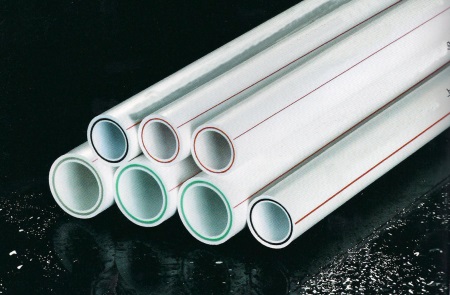
Piping diameter
Choosing the right diameter is also important. If it is not enough, due to the turbulence of water flow on the walls will be deposited more lime, and the movement of water will create more noise.
The diameter is selected, taking into account that the water should move at a speed of up to 2 m/s. It is also important to base the choice on the length of the pipeline. Pipes with a diameter of d 20 mm will be enough for a length of up to 10 m, for a length of 10-30 meters suitable pipe diameter of 25 mm, and for longer pipelines choose pipes d 32 mm.
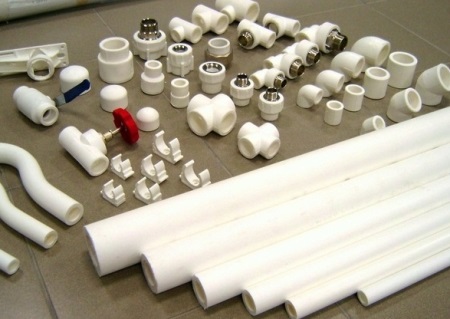
To correctly determine the diameter of the pipes for a house with a large number of occupants, it is important to consider the simultaneous water consumption in the house - how many appliances and taps will be turned on at once (how much water they will pass per minute). For a small family, but with a large number of water-consuming appliances, you need to calculate the total water consumption of all outlets, and then subtract 25-40%.
Welding polypropylene pipes
Connection of pipes made of polypropylene, including reinforced, is made by welding:
- Pipes are cut with special scissors, obtaining pieces of a certain length.
- The welding spots to be cleaned are marked using a damp alcohol wipe.
- After installing the necessary nozzles on the welding machine, turn on the device and set the temperature on it.
- After heating the machine (the lights go out) push the pipe sections on the nozzles to the marks, but without turning.
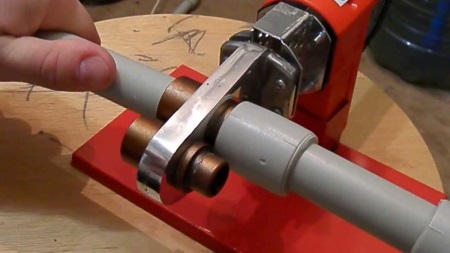
When the pipes are already connected, wait a few seconds and remove the nozzles (let your helper hold the machine), then clearly and quickly connect the pipes and hold them together a bit. The result will be an even connection. When you don't like the result, the connection section is cut off and the procedure is performed again. The welded pipes are left to cool for a while, and then used.
Plumbing in private homes
- Prepared pipes are laid in the house, starting from the water consumers.
- Pipes are connected to the consuming point with an adapter to allow the installation of a valve to shut off the water.
- Pipes are laid to the collector. It is advisable not to run the pipes through walls and partitions, and if this has to be done, enclose them in glasses.
For easier repairs, place the pipes at a distance of 20-25 mm from the wall surfaces. When installing drain taps, create a slight slope in their direction. Pipes are fixed to the walls with special clips, installing them in straight sections every 1.5-2 meters, as well as in all corners. Fittings and tees are used to match the pipes in the corners.
When connecting the pipes to the manifold is always installed shut-off valves (it is necessary for repairs and the possibility of turning off the water supply).
Try to make a minimum of corners or turns, so that the pressure is lost to a lesser extent.
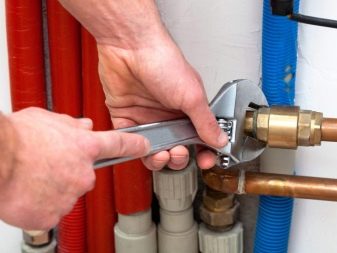

Running water from a well
The well water comes from shallow strata, so it often has many impurities. Such water without purification is used for domestic, as well as household needs, and to make it potable, you need to perform water treatment, having previously passed the water for analysis. The main advantage of the device well is that its construction does not require permission from state organizations.
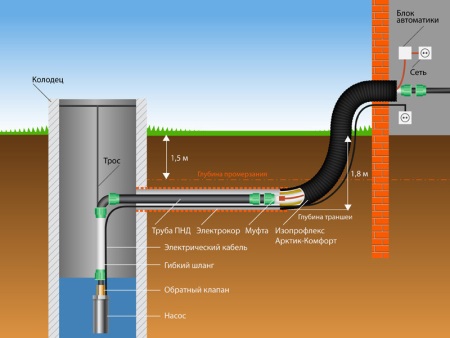
Conducting water from a well
Because the water comes from deep layers, it is cleaner than well water and has a stable chemical composition. More often than not, such water is free of microorganisms and harmful compounds. Choosing this type of water source for a private home, take into account that the drilling of a well requires a project and its approval.
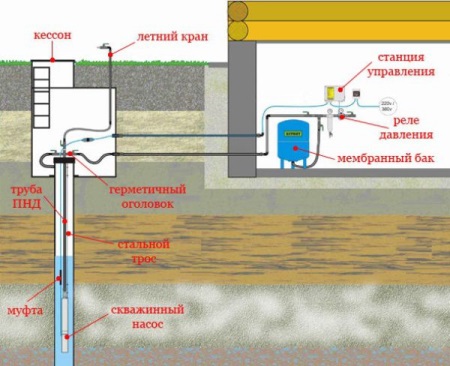
Centralized water supply
Ideally, the water supply for a private building should come from a well or borehole, as this will give your water supply system autonomy. However, it is possible to connect the building to the central water supply (even if it will be a backup source).
You need a permit to connect to the water mains. Engineers from the central water supply company will evaluate your design, the capacity of your pump, and the amount of water consumption. Meters will also need to be installed to monitor your water consumption.
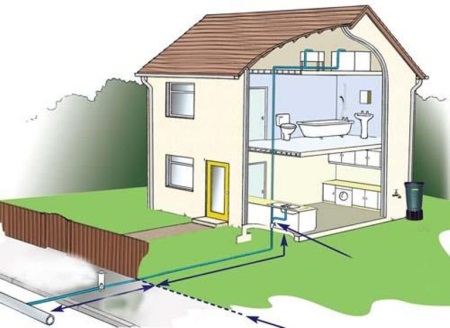
Plumbing
The outside part of the water line can be laid openly or hidden in a trench. If you have chosen the underground option, it is important to install the communications, taking into account the depth of freezing of the soil. When installing the pipeline above the frost level or above the ground, you should take care of thermal insulation.
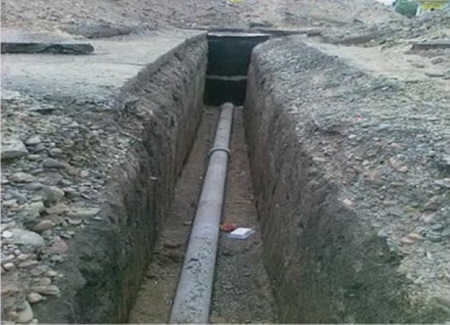
Pumping station
Pumping water from the source is pumped by the pumping station, which is usually located in the basement, on the 1st floor or in the basement. It is desirable to place the station in a room with heating so that the water supply works in the winter. On the pipe from the source, coming to the pumping station, a fitting is put, so that during the repair of the water supply can be turned off. A check valve is also connected.
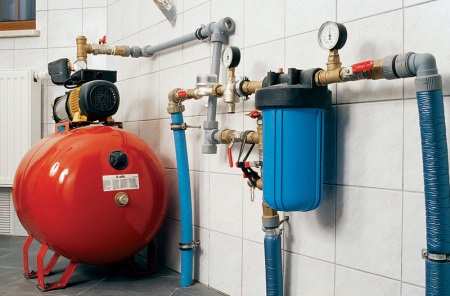
If it is necessary to make a bend in the pipe, you must use an angle. After that, a ball valve, filter for coarse filtering, pressure switch, hydraulic accumulator (if the pump is located in a well or in a well), sensor against "dry" running, filter for fine filtering and adapter are installed with a quick connection. Finally check the function by starting the pump.
Hydraulic accumulator
It is represented by a sealed 2-section tank with water in one compartment and air, which is under pressure, in the other compartment. Such a device is necessary for the stability of the pressure in the system, on/off the pump. When you open the faucet in the building, water will leave this unit, which reduces the pressure. The result will be to trigger the relay and turn on the pump to increase the pressure.
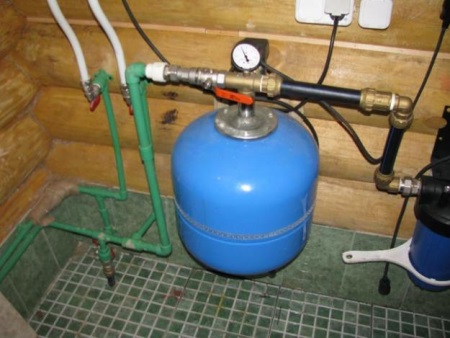
The volume of the tank is chosen according to the needs of the people living in the house. It can be 25-500 liters. Installing a hydroaccumulator is not mandatory - you can use the storage tank on the top floor or attic, then the pressure for the flow of water will be created by the weight of this tank. However, this system is not suitable if you have a washing machine in the house.
Water treatment and treatment
The water in your source will need to be tested in a laboratory to determine soluble salts and other impurities. This is necessary for the selection of filtration systems. After passing the hydroaccumulator, the water enters the water treatment system, located from it in 0.5-1 meter.
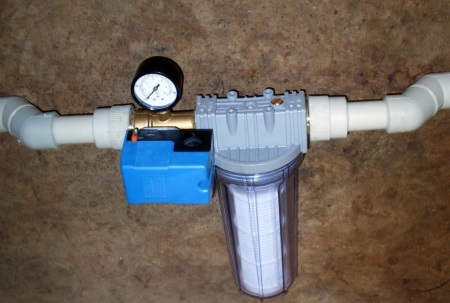
Manifold and boiler installation
After the purification system, the water is separated into two streams. One is intended for cold water and goes to the collector, and the second is intended for hot water and goes to the heater. On all pipes of the collector and before it is mandatory to install a drain valve, as well as shut-off valves. The number of pipes will be determined by the number of water consumers.

A drain cock, a safety valve and an expansion tank must be installed on the pipe leading to the heater. You will also need a drain valve at the point where the hot water will be coming out. The pipe is then routed to the manifold where the hot water will be.
Care and repair
The function of the water pipe should always be monitored, and any leaks and other problems should be repaired without delay. If there is a small leak, a rubber gasket can be installed at the point of damage, secured with a clamp.
For quick repairs, you can use cold welding, mopping up the area after degreasing with acetone.
With a fistula in a new pipe, a bolt is screwed into the drilled hole (if the pipe is old, this method is not suitable, as it will lead to an increase in the fistula).





I buy polypropylene pipes - I think the best option for me.